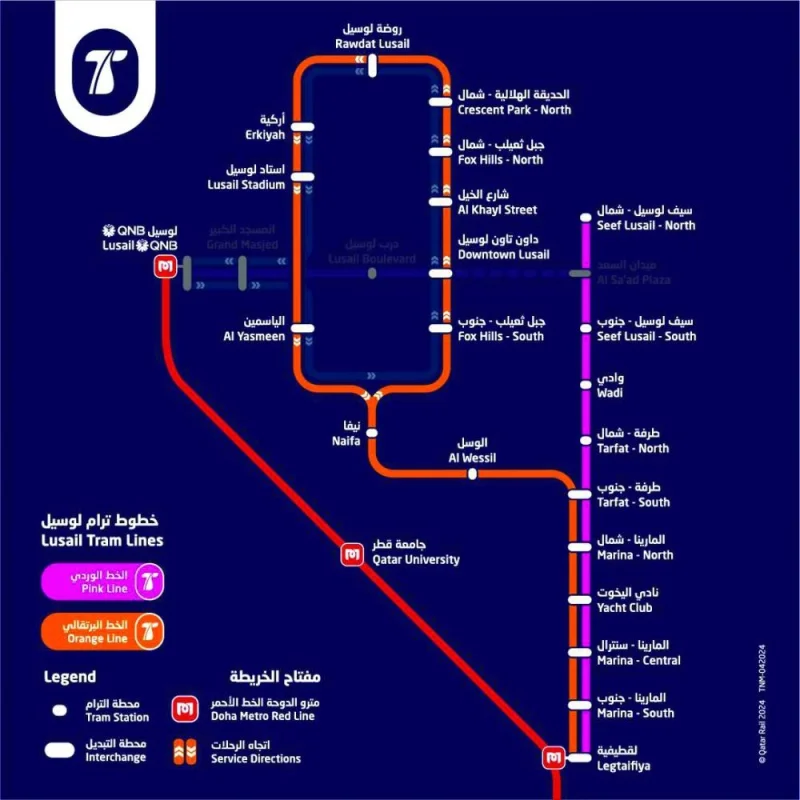Earlier, Qatar Rail announced the launch of the Pink Line and the completion of all Orange Line stations. This, al-Saleh pointed out, will encourage the riding public, including visitors to the country, to utilising the tram, thus maximising their regular commute.
For the first time, the services of the tram network now included the operation of at-grade stations and the tram moving alongside traffic and pedestrians in Lusail City, noted al-Saleh, who reminded the public to always use the validators to ‘Tap In & Tap Out’ upon boarding and alighting the tram.
“Furthermore, Qatar Rail has coordinated with various partners in the Ministry of Transport and the Ministry of Interior to conduct awareness campaigns aimed at introducing the tram system and emphasising the importance of pedestrians and drivers adhering to traffic safety guidelines, signs, and signals.
“As a result, we've joined forces with our partners to initiate awareness campaigns focused on promoting road safety and responsible interaction with tram trains in Lusail City. This is particularly important considering that the tram system differs from other vehicles on the road. Trams run on fixed tracks at a steady speed and cannot stop as quickly as cars,” al-Saleh stressed.
He also underscored the Lusail Tram’s eco-friendly features, providing a greener and more efficient alternative to cars. The tram relies on ground-level electric power supply, uses LED lighting systems, and state-of-the-art electric braking systems, he emphasised.
Al-Saleh said: “Additionally, trams are much more efficient in terms of road usage, as one train can replace about 40 cars, which occupy a significantly larger area of road space, contributing to reducing the negative impacts of transportation, especially Co2 emissions.”
He added: “We are dedicated to providing sustainable and safe transportation for the residents and visitors of Lusail City. We remain committed to continuing our efforts in ensuring the highest standards of safety in the tram network to ensure safe and efficient operation at all stations and facilities.”
Lusail Tram facts
Once the full tram network opens, it will connect various government offices, residential towers, leisure and sports facilities, avenues, marinas and other major attractions across Lusail City.The Lusail Tram trains were manufactured in France by Alstom, which is one of the largest train manufacturers in the world. The Lusail Tram fleet consists of 28 ‘Citadis X05’ trains that use ground power supply technology.
Each tram train consists of 64 seats and a comfortable capacity of 209 passengers in both Standard and Family Class. The trains have six screens to display travel information and around 20 USB ports.
The tram differs from the metro in that each tram has a driver and its maximum speed is approximately 60km/h. Trams are considered environmentally friendly systems, using LED lighting and electric brake systems.
Travel cards work across both the tram and the metro with no additional costs; however, customers must always remember to Tap In & Tap Out using the validators onboard the tram to avoid paying twice.
Each station contains a customer information centre, Travel Card vending machines, live digital service updates, separate male and female prayer facilities and restrooms that cater for people with mobility impairments. The stations also include clear directional signages to help customers navigate throughout their journey easily.
All stations are equipped with CCTV and a first-aid room to maintain the security and safety of all customers.
The design of the Lusail Tram was inspired by ‘Al Mehmel’, which signifies ‘The Dhow’ – a traditional Qatari boat used for pearl fishing. The concept focused on the sea and dhow pearl fishing, incorporating calm, cool, elegant, and tranquil elements into the design.
Inspired by the local Qatari heritage and its historical legacy, the interior design of the stations was developed on 3 levels; colours imitating the local traditional handcrafted textiles and the stained glass used in local windows.
Patterns are derived from gypsum engravings used in local houses, majlis and palaces. Textures of clay used in historical fortresses, towers, and souqs are reflected on walls and floors and vintage geometrical ornaments are accentuated and used in multiple locations.
Existing Doha Metro travel cards will allow customers to seamlessly move throughout the metro and tram networks as well as provide access to Metroexpress and Metrolink services.




